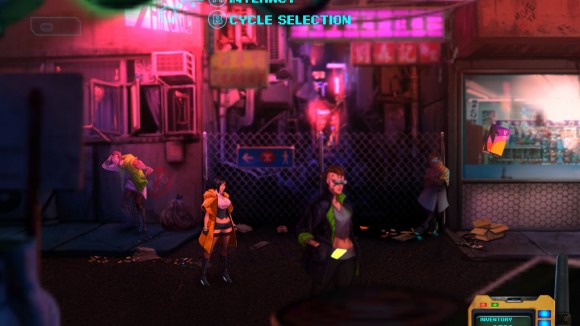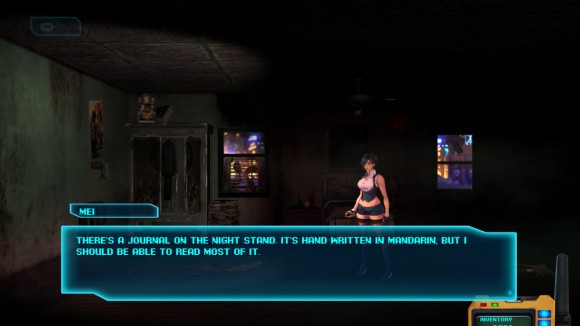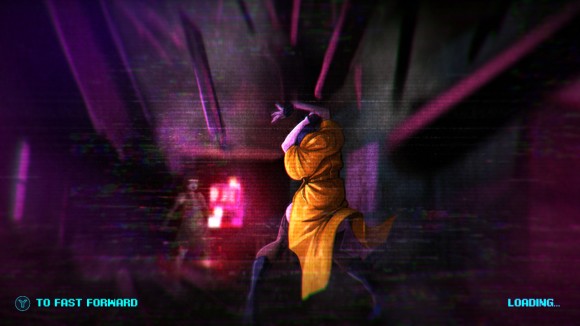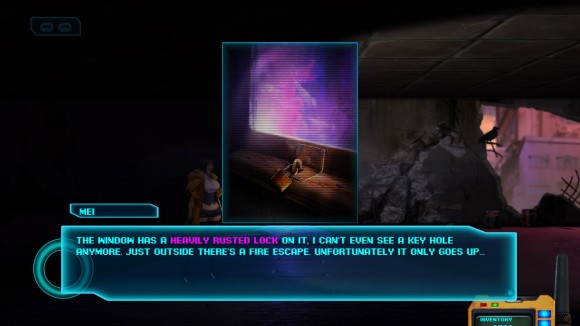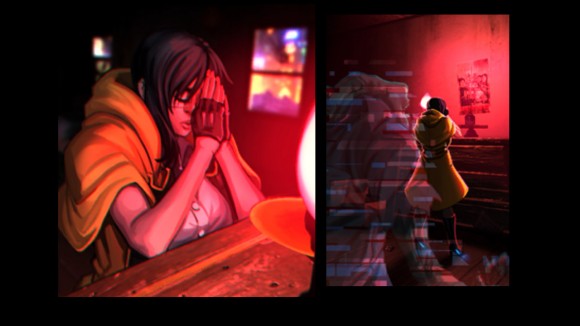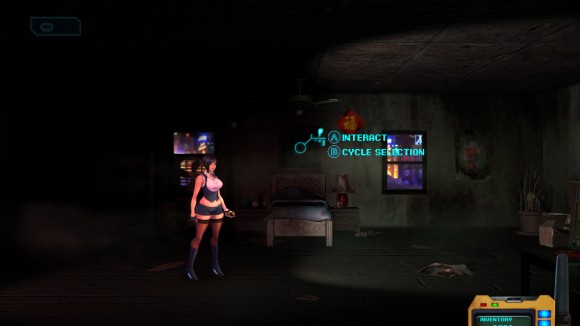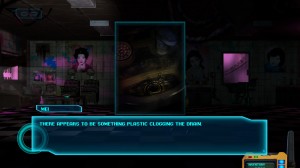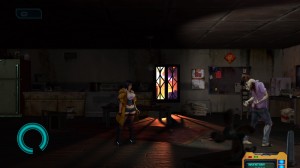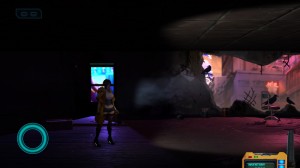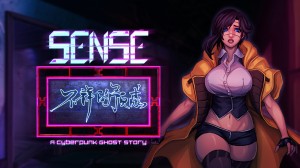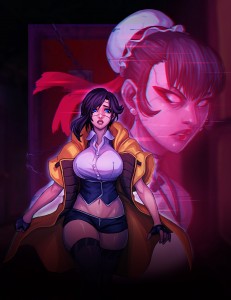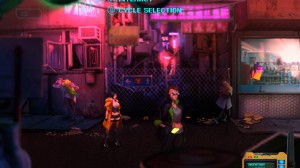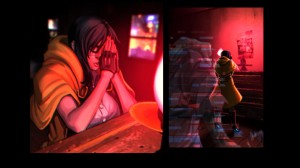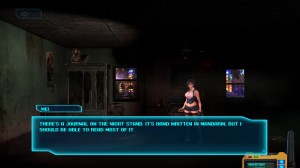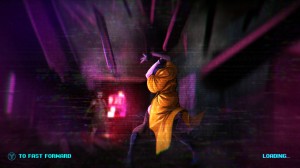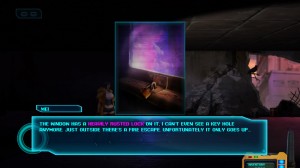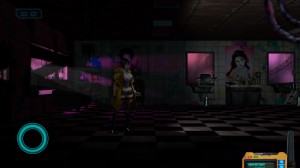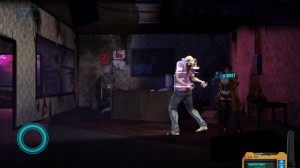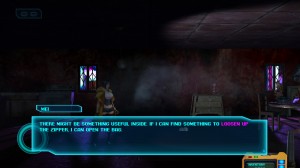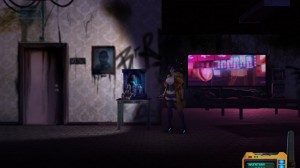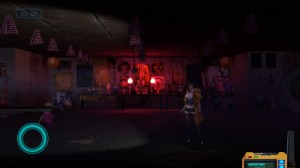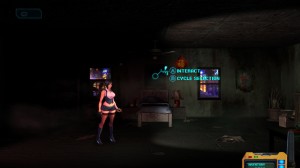Game: “Sense: A Cyberpunk Ghost Story”
Sense: A Cyberpunk Ghost Story

Sense: A Cyberpunk Ghost Story is a 2.5D side-scrolling horror game set in the cyberpunk dystopia of Neo Hong Kong in the year 2084. The player controls Mei-Lin, a young woman with cybernetic eyes who finds herself drawn into the 100 year old tragedy surrounding the Chong Sing apartment building and its inhabitants.
At A Glance:
| Visuals | 7 / 10 |
| Sound | 7 / 10 |
| Gameplay | 5 / 10 |
| Overall | 6 / 10 |
| Positives | + Excellent backdrops & comic book story panels+ Compelling character histories & interactions
+ Great enemy variation & design |
| Negatives | – Far too much backtracking – Combat is both sparse & horribly janky
– Questionable portrayal of its female characters |
The story begins as Mei-Lin travels across town on the subway, heading to a bar in a rundown part of town for a first date. Neo Hong Kong makes a fantastic first impression – you have bright neon lights illuminating dingy streets filled with even dingier characters, and the setting feels exactly right for the premise. Eventually finding the bar, Mei-Lin heads to the club’s bathroom to investigate a problem with her cybernetic eyes before inexplicably finding herself in the bowels of the Chong Sing building, confused and alone. You must help her safely navigate the dilapidated building, solve puzzles and exorcise the vengeful ghosts of the residents in order to get out alive.
The environments within the apartment building are decidedly less vibrant than the streets of Neo Hong Kong, and I have to say that they look great despite not offering a lot of variety. Each dingy apartment is similar enough to the last to feel like they all belong to the same apartment block, but each has a few individual touches to hint who had lived there once-upon-a-time. The former inhabitants haunting the apartments are wonderfully drawn too, with each spectre given a distinct look that makes each of your enemies really stand out. From the maniacal Dr Lai, the heartbroken Mariko or the beheaded office manager, there’s no mistaking you’re dealing with a collection of tormented individuals and not a generic group of spooks, though it does take rather a while for their stories to all tie together into a meaningful plotline.
Early on, Mei-Lin has no means of defending herself from the ghosts of the Chong Sing building and you’re forced to avoid them entirely – bump into them once or twice and our heroine will suffer a pretty gruesome death. Leaning heavily into Cantonese folklore, overcoming the ghosts takes a more spiritualist route than many other horror games might. Mei-Lin must gather information and items from the spectres past and create a shrine in order to set their souls at rest. Banishing the ghosts through prayer is a wonderfully unique way of defeating the enemies and feels incredibly characterful to the game, though it does become a little rinse-and-repeat after a while.
Combat is finally introduced about halfway through the game but once it does show up, it’s so horribly janky that I half-regretted pining for it at all. Handled entirely through quicktime events, Mei-Lin should strike or dodge at the push of a button at the right time – only often, she doesn’t. Responses to the QTE’s are very hit and miss, and with the game so unforgiving, you can quickly find yourself dead and forced to replay an entire section over again if you hadn’t dropped a quick save immediately before the encounter.
Mei-Lins story is mainly delivered through a series of beautifully drawn graphic novel frames that are truly a treat to watch. These frames regularly punctuate the gameplay and really help to add some depth to the experience; locations and characters are drawn in great detail and the coinciding sound effects and snippets of voice acting bring a sense of real action despite being a series of still images.
In fact, the sound in Sense deserves some praise too. Despite mostly comprising of a combination of footsteps, clatters and groans, the soundboard manages to add a great amount of atmosphere to the decaying Chong Sing apartments. My only criticism is that the music, while excellent, is used too sporadically – the rooms set to a score carry a real sense of tension that is sorely lacking in the rooms filled only with silence.
As the core mechanic in progressing the game, the puzzle solving in Sense is a pretty mixed bag. There are some rewarding examples where the game expects you to check through the entries in your journal and decipher lock codes on your own, and these come off as a nice amalgamation of storyline and gameplay, but the run-of-the-mill puzzles come with significantly more headaches. Mei-Lin comes across a plethora of items as she investigates the Chong Sing apartments, and it’s infuriating that you aren’t allowed to pick up items that will clearly be of help later (like a screwdriver) until you run into the situation that requires them. Even more annoying is that some items, seemingly of no use whatsoever, are collected without question. The game teases a way to track helpful items on the map but this never appears – instead you find yourself scribbling notes on a real-world piece of paper, and then endlessly backtracking between rooms to collect the items that you knew you’d need in the first place.
Not only incredibly tiresome, but all of the travelling back and forth really hurts the atmosphere of the game; you’re faced with a short loading screen every minute or so and it can feel like you’re doing as much waiting as you are playing. In one puzzle sequence that required me to travel from one side of the floor to the other, and then repeat the journey, I counted no less than 33 loading screens before having everything I needed to complete the puzzle and had returned there to solve it. That’s about 25 too many in my book.
The travelling is frustrating enough when the puzzles and their solutions are all contained on a single floor, but it’s downright infuriating when you have to walk from one level to another, traversing the whole of each floor on the way, for an item you walked past hours earlier. There’s a handy lift in the building that could alleviate this problem, but it’s out of action for almost all of the game, and once it’s reactivated, you hardly have any use for it anymore. I appreciate that backtracking is a staple of the survival horror genre, but the sheer volume of wandering around in Sense smacks of a team keen to extend the length of the game rather than the enjoyment of it.
Top Hat Studios is brave enough to flirt with some pretty dark subject matter, and not just in the gore and gristle that you might expect from a horror game, though there’s plenty of that to go around too. Later in the game you’re introduced to characters battling surgical addiction, domestic abuse, and transphobia; things that I didn’t expect to run into when I began the game. The issues are woven into the characters backgrounds through some well-written journal entries and I’d say that they’re raised in the right way – I was mostly left feeling that these characters were rounded people battling with these problems and not just cardboard illustrations of issues in order to be edgy.
But while I think the studio took the right approach on those tricky issues, I definitely raised an eyebrow at the visual depiction of the female characters in Sense. As just a quick glance at the cover art will tell you, the proportions and body images of the women in the game are a little ridiculous. In a masterclass in objectification, every woman is ludicrously big breasted, has a tiny waist and is dressed in pretty revealing clothing. Despite Hollywood always drawing a pretty straight line between horror stories and unrealistic leading women, it’s disappointing to see games developers following their lead. In all honesty, I find it more unnecessary and distracting than offensive, but it would be short sighted of me not to understand some of the furore surrounding the issue online.
Sense takes clear inspiration from the granddaddies survival horror, the original Resident Evil and Silent Hill games, but made on a much smaller budget, struggles to emulate the formula that made them successful. What made those games so special was the mixture of tension, puzzle solving and action – something missing from much of Sense, outside of a couple of fleeting chase scenes. I can appreciate the attempt at making this a story-based, spooky affair, where you’re on your toes wondering when the next scare might come, but the action is just too sporadic and you’re left feeling a little underwhelmed rather than on edge.
All that taken into account, I have to finish off by saying that I enjoyed Sense in spite of its issues. The visuals are murky and bright enough in the right places, environments are filled with interesting enemies with vibrant histories, and the slow-burn plot line comes to a nice conclusion that leaves you with a sense of satisfaction. Had the developer been less self-indulgent with some of the design choices and added more robust and regular action sequences, I could recommend this to all players, rather than just the die-hard survival horror fans that it will appeal to naturally.
In the interest of full disclosure, the publisher provided VGamingNews with a copy of the game in order to conduct this review.


